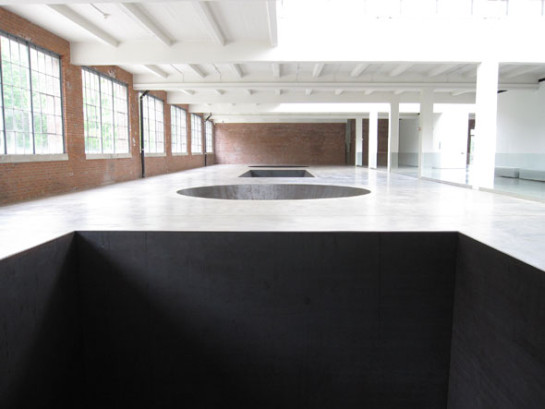
Robert Heizer
“*I am what I am*. This is marketing’s latest offering to the world, the final stage in the development of advertising, far beyond the exhortations to be different, to be oneself, and drink Pepsi. Decades of concepts in order to get to where we are, to arrive at pure tautology. I equals I”.
The Invisible Committee.
One of the questions one is often confronted with is to explain why or how an artwork has value, or quality. Now, in one way, this blog has often been about exactly this, but what I’m more thinking about here are the prevailing assumptions this culture demonstrates in it’s non specialized outlets. Given that there is so little arts education anymore, I often find distinct prejudices about not just what is valued, or what is popular, but about how to even begin talking about the subject. When I taught at the Polish Film School (http://www.filmschool.lodz.pl/) I often taught first year students in a sort of overview of film aesthetics. I would often ask what films students thought important, or their favorite director. I usually found pretty predictable responses: Coppola, Scorcese, and Kubrick. Occasionally a Tarkovski or Kurosawa would be mentioned, and quite often Speilberg and Aronovsky or whoever might be flavor of the month at that time.
Now, this was a film school, so presumably these were students with more than a passing interest in aesthetic questions. I suspect if one asked a similar question of first year students at a small state University, in a class unlrelated to the arts, one would get many more answers linked directly to just popularity.
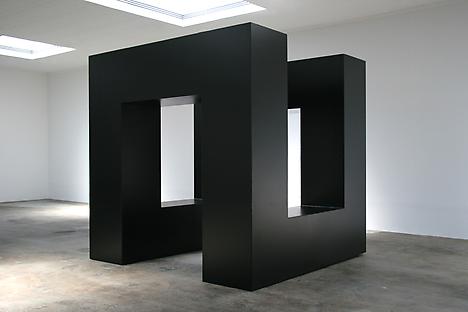
Tony Smith
How does one begin to explain the Tony Smith sculpture (in the above photo)? Smith, a New Jersey born artist who once clerked for Frank Lloyd Wright and later was associated with the Abstract Expressionists, might firstly be looked at in terms of what he isn’t. He isn’t corny or sentimental, and there is an indelible clarity to the space his work creates, and mediates.
Harriet Senie, in Sculpture Magazine, wrote:
“Considering Smith’s work in its entirety, as this exhibition so ably makes possible, one approaches it somewhat as one approaches infinity never quite seeming to grasp its essence fully. Always on the edge, eluding us even as we near it, it remains a powerful expression of complex visual thinking about essential structure and the possibility of a larger order of things. Judging from some recent visits to MoMA, it may be that, as in the late ’60s, Smith’s work is again being shown at a time when it is in a fundamental way at odds with current art practice and criticism. Thinking grandly, perhaps at times grandiosely, Smith’s words and works challenge the prevalent distrust, if not disparagement, of a generation of artists who thought themselves capable of taking on the world. We might, now that we have a clearer view of the socio-political context in which they worked, do well to reconsider the possibility that their words were spoken in good faith and their works made with the intent to expand rather than limit the range of human potential and understanding.
Tony Smith’s art is difficult to grasp visually, verbally, and intellectually. It offers a pre-Pop experience. What you see is never all there is because from a different angle you always see something else. It requires that you look seriously and think about it. But if you choose to engage it, it prompts musings about complex structure, the meeting of impossible opposites (like anthropomorphic geometry), the nature of infinity, and the impossibilities of easy answers and labels.”
This is another way of saying, it’s extremely difficult to articulate why Tony Smith is a major artist.
Here is a commissioned work designed, really, by a firm, but mostly by Ean Eldred:

Ean Eldred
Now, OK, in a sense this is unfair. I know all the reasons, but it remains difficult to express why Smith’s work is considered major and the Eldred not. On some primal level, the Eldred is just ugly. But what does that mean? One thing that Ms Senie said is correct. There is something in the Smith that asks you think seriously about it. Again, however, what does that mean? There will be a temptation to question the context of the work, where it is placed, and what influence prior knowledge of the artist helps shape the response to the work. If I said the second piece was also by Tony Smith, or by Donald Judd or David Smith, would it be looked at differently? Of course it would, but I’m not sure it wouldn’t still be clear the second piece is just dreadful. Now, the onset of pop, and post modern thinking, not to mention the introduction of irony to all discussions of art shifted a lot of how the public responded to work by people like Oldenburg.
Now, I don’t want at all to get into some overview or retrospective of American sculpture, but only to suggest that with the rise of a fan culture, a commodity driven sensibility that saturates U.S. society today, coupled to the degrading of language, the vocabulary just isn’t there to really talk about art anymore. In fact “art” is rather a bad word. Use the word “art” in a sentence and I guarentee you people will sneer. Part of this is the training of public taste by corporate media. What is being dismantled, besides language, is the capacity to reflect, and more importantly the capacity to grasp the contours of one’s own emotions. Today, mass culture is defined by film and television. People do not talk or tweet or post memes about sculpture or public art and rarely about painting, dance, or theatre. The vast majority do, however, engage in discussion about film and television. In fact, there is increasingly a merging of pop cultural references with almost everything. Op-eds and sports columns, and pod casts about any topic from gardening to space travel will include tropes from popular TV shows and films. I often wonder in exactly what way some of these references operate. The most popular film of 2012 was Joss Whedon’s The Avengers. I did try to sit through all of it, but just couldn’t. But I did see most of it. If you check Rotton Tomatos, a site that collects film reviews, The Avengers got a stunningly high 92% approval rating. Last time I saw that high a score was, I believe, Hurt Locker. So, what does this have to do with Tony Smith? Well, I think it has a lot to do with everything, actually.
Jonathan Jones, The Guardian art critic (and not a bad one, actually) went on a small rant a couple years back about bad public art…
http://www.theguardian.com/artanddesign/jonathanjonesblog/2007/nov/16/publicarthasgoneoffthera
Now, this relates to a couple things; but mostly it has to do with the loss of taste, for lack of a better term. Probably the worst failure in taste has to do with questions of realism. That’s the first thing. A fear of abstraction. Everyone knows the kistch sensibility that will create sculpture or painting that is largely impressionistic, shall we say, but retains at least one clear representative figure, on clear “thing” that anchors the whole. Or, a realistic painting, or sculpture that tricks out the edges with bits of abstraction. This is simply the idea of expertise that holds such influence, but also that basically Americans view art with suspicion. It is that Puritan ethos of art as frivolity. Making money is what matters. Hard work, and a refusal to be sidetracked with these feminine arty distractions. The fact that the entire culture is orchestrated by various distractions hardly matters. Social control means total social control, it means controlling leisure time as much or more than work time. And really, they can’t be seperated now anyway.
But back to a question above. How do references to Walter White or Arrested Development operate in day to day discourse? I think most people would keep it a secret if they had failed to watch a particular hit show. It is a sign of being somewhat weird. So, to what degree does the general public see the fascist message of films like The Avengers? The answer is, probably, not much. Most people will instinctively react by saying, “oh its just a comic book”, or “it’s just a dumb popcorn movie”. And yet, the fans for these products are rabidly loyal and possessive.
“Absolute freedom in art…contradicts the abiding unfreedom of the social whole. That is why the place and function of art in society have become uncertain.”
Adorno

Imperial County, California
Some of the debate about autonomous art goes back to Trotsky, and later Lukacs. Adorno believed that no message in any narrative or artwork could do justice to the long gradual pertinacious consolidation of Capital, and of fascist rule. The historical forces in a sense will always be trivialized by a single artwork, and that rather, the impact of a narrative or image has less to do with praxis than does the hidden truth content of that artwork. And that hidden potential, what he described as truth content, is closely linked to the aesthetic autonomy of its creation. Now, if one looks at the degraded landscape of popular taste, chained to the ideological values of profit and success, the result is a development of a pseduo taste, a valorizing of kistch. Which means a familiarization with product, with it’s context in the Spectacle, and with the rise of a fan identity. Kitsch taste means developing an expertise in yourself as consumer. Star Trek groupies are perhaps the extreme end of this, or those attending comic book conventions, or somehow constructing elaborate theoretical justifications for being fans (China Meville comes to mind). The expert consumer knows every episode of his or her favorite show, and spends a good deal of leisure time shuffling around this knowledge and making lists (top ten sci films of the 90s, etc). Any other approach to cultural product, to art, is being forced off the shelf, for shelf space is being bought up the major studios and media giants. And the message of Whedon and the entire sort of comic book world is that we live in a world of gods and meaningless humans. Its a child’s world view, that death does not exist, that you can die and jump right back up again. It is also, a world in which the studio executive and producer and directors are Gods, immortal, battling for box office on Olympus. But..there is another effect of educational regression, and this occurs in the reduction of all matters of taste to a child-like infatuation with noise and shiny colors and with very one dimensional comic book characters. Now, this also retains elements of Puritanism. Black teenagers are stigmatized for wanting new trainers, or for developing their own style codes (style often stolen by the corporate fashion world). Only the rich are allowed to enjoy the quality of cashmere or handmade clothes, or possess fine watches or drink expensive wine. The masses must consume fantasy product, and endorse the validation of profit as a criteria. They cannot exhibit their own aesthetic codes. It is really “shopping” that is the one skill to which approval is granted. Celebrities can show taste. The poor are shamed for spending on “unecessary” luxury items. The rich are applauded for spending. Jay Z buys his wife a jillion dollar hair comb or something, and is applauded for demonstrating such devotion and love. A welfare mother is stimatized for buying nice wine (or trying to) with food stamps. Food stamps are for pink slime and cheap macaroni.
So, the aesthetic education and background needed to find the grammer of appreciation for a Tony Smith sculpture is the very thing least encouraged today in education. Even in elite schools such questions are prosscribed as relics of some distant less hip era. In the Smith scupture above, what one sees is something elemental, the sense of weight, of altering space, of an insistance on attention to the actual material, all of which is exactly what one does not see in, well, The Avengers (or almost any popular commodity, whether film or TV or literature). One can feel the same emotional confrontation in Kafka that one feels with Smith.

Richard Serra, Te Tuhirangi Contour
The demand for depth, for formal and emotional depth is far different than communication. The idea of even direct clear communication is not the goal of artworks (or philosophy for that matter, or ritual or religion even), for as the instrumental world of colonized thought, the insistance on blind obedience and marketed fear, are all best served by comic book and sci-fi adolescent fantasies. The further divorced from originary mimetic experience, the more absorbed the fan will be in his or her screen reality. Binary world views, thumbs up thumbs down, like nor not like. Rate it and make a list. I have said before that the populace today, the mass audience, processes narrative and image in ways that resemble mild autism. There is additionally, of course, the inculcating of very simple value systems. And those values are akin to what one used to see in Dick and Jane second grade readers.
The inability of most of the mass audience today to recognize sentimentality, say, or cliche, or an obvious triteness, is very clear. What is, perhaps, more complex is the way in which irony has attached itself as a subject position to then more easily read a the repetitive nature of these simple stories and basic coloring book images. If Oldenburg once looked to adjust scale and texture to comment on a blindess to the commodity world around us, today the pop sensibility is one which irony is just an irony that comments on nothing. It is only an empty endless loop of snark and attitude. Again not disimilar to what one finds in ten to twelve year olds.

Ptolemaic period, 305 b.c.
Another side bar to this is that having taste, learning a respect for the quality of the not just what is created, but the world around you, is being ridiculed, its archaic and old fashioned, and somehow unmodern. Technology links closely to expertise. The rise of geek culture is just allowing a re-branding of, and validating of, a closed ended expertise and ability to weild techonology. in the service of one form of consumption or another.
Access to technology, of couse, is in exact proportion to one’s income. The invasive state and its monitoring and testing and restricting of movement and ability to carry out daily demands is also in direct proportion to one’s income. The rich are not drug tested. The rich, of course, do not go to jail. The rich are not asked to show ID, and police do not stop and frisk in rich neighborhoods (unless a black or brown person is uppity enough to pass through that neighborhood). These realities are treated narratively in all studio film and network TV, but they also are embedded as an effect of the infantilizing of the society at large. The aesthetic of Windows 8 is that of bath tub toys. The promotion of cute, of cupcakes and the ironic wearing of children’s clothes, are all with specific political messages attached. Nothing exists in a vacuum.
There are moral dimensions to an engagement with artworks. The repression of forgetting, the acceptance of child like points of view, are all assisted when aesthetics are homogenized. When they are simple, bland, and child like. Children are naturally needy, and today the state and its military and police extensions are more and more the parent who holds your hand as you cross the street. The new geek or hipster is just playing dress up. The parents are amused their kid knows so many technical tricks. Its all a backyard play. The pre-pop sensibility of Tony Smith, or Serra, or Carl Andre or Judd, are almost the opposite. Cute is crushed. That kind of weight, that kind of caressing of the brutal echos primordial dreams of what children once saw with wonder. The night sky, the cold water of streams, the salt and power of ocean waves.
There are artists working today who eschew the baby toy cuteness and irony of Jeff Koons. Or the post Warholian embrace of mediated narcissism. A sculpter such as Hiroyuki Hamada, as just one example, brings a sense of constituent space to examinations in black and white of what feel like dream shapes. The sense of dreams gone wrong, often; his work suggests how little it might take to lose all sense in of balance in this world of state mandated violence. The small pocked surfaces, the chipped edge or tilted top to an amorphous shape registers as something we ‘think’ we know, but which then upon immediate reflection we are less sure about.
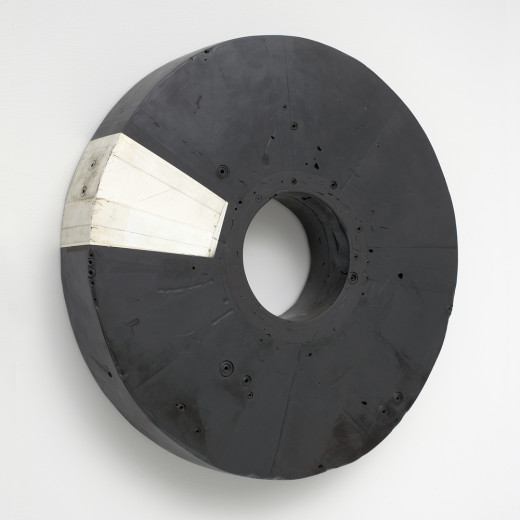
Hiroyuki Hamada
Context, of course, always intersects with an artwork. Autonomy is never not mediated. The growing deserts and eco-cides of the planet, the migrations of people and animals and even weather now, lurks behind the forgotten. We forget, and yet we don’t. Artworks must create negative truths without a tongue, with the hemorrhaging eyes of those trampled by a never stopping machinery of violence. Out of this can only be work that is difficult if not hermetic and cryptic in some way. Nothing not a secret is worth knowing culturally.

Hugo Simberg
When I was ten years old, I was rushed to Children’s Hospital in Los Angeles with a gangrene gall bladder. My parents were told I would die. I was in the hospital for ten and a half months. I got secondary blood infections and went into a coma for a week. But during that month in which I was very sick, I ran a high fever, up to 104 at times. And I had a recurring dream for that entire month. I saw a bright sky, a pale yellow sky, and I was unable to see to either side and this caused me, in the dream, some anxiety. Stretched taut across the exact middle of this sky was a filiment of some sort, like fishing line. Balanced on this line was a giant boulder. It was reddish brown, and seemed perhaps a volcanic rock somehow. But I could sense its weight. In the dream it simply teetered back and forth. Sometimes a great deal of teetering and other times very little. It never fell. The dream returned countless times, always the same. I felt some dread with this dream. Not exactly fear but a kind of dread. A foreboding. I mention this because medicine has no way to tell me what that dream was, or meant, or why I had it. It is a great mystery. This was almost exactly fifty years ago. I still have a vivid and clear memory of that dream. I have not had it since. It is a primal dream of some sort. Science can tell me nothing. Nobody call tell me anything, except perhaps a shaman, if I knew one. An ancient oracle perhaps. But the cynic will tell that is silly. It’s a dream. Nothing more. A dream. I had a high fever. I had a weird dream.
I don’t believe that.
The Hugo Simberg painting above is steeped in something. What makes it so convincing? Why is it not corny? Part of it is color. That is not the yellow of bath tub tub toys. Bill Gates would NOT have signed off on that color. It is the color of a feverish dream. It is a virus or bacterial yellow. And yet, it is not an ugly yellow. And that is what why it is a great color. If it were an intentionally ugly yellow, the painting would be kitsch. It would be melodramatic.
There is, also, the question always of narrative. In theatre, when I first started, we worked in very low rent spaces. I helped build the sets and we distressed things and painted walls and floors. I felt as if the audience were entering a Keinholz piece. Later, as I found my plays being done at bigger theatres, though I still directed them, they were gradually getting away from me. The system was mediating the space. So I think I instinctively adjusted the plays to find their way back to their origin by creating those Keinholzian spaces by way of text. Storytelling is ancient. To kill a story is not easy. You have to really want to suffocate the fucker. They are designed to live. But, today’s institutional theatre really wants them dead. They hire whole firing squads to shoot them down like rabid dogs. The play bleeds out in rehearsal rooms while dramaturgs and producers stand, rifles in hand, watching the life seep away.
One of the things I always say to students about writing plays, and to a degree screenplays, is that character comes out of dialogue, not the other way round. Language lives, independent of the writer’s intentions. Which is why outlines are like the cutting the throat of the play, another way to kill it. Yet, almost every University writing program I know, says quite the opposite. I often think, as I did the other day, watching The Avengers, that in it’s way, at least this has the virtue of a certain honesty. Most theatre I see is work that masks it’s deep totalitarian impulses behind a veneer of humanist cliche. Does it matter that young audiences learn to sniff out this deceit? Of course. If for no other reason than to sniff out the obvious State Department propaganda. This week a planted story on Pussy Riot was making the rounds. A bad bit of theatre. Badly cast, too. I actually believe that if students read nothing but Shakespeare for two years, at the start of high school, they would know far better who was so openly lying to them.
Read Fanon, and read Melville, and Dostoyevsky, and Dante and Donne and Pinter and Kafka.
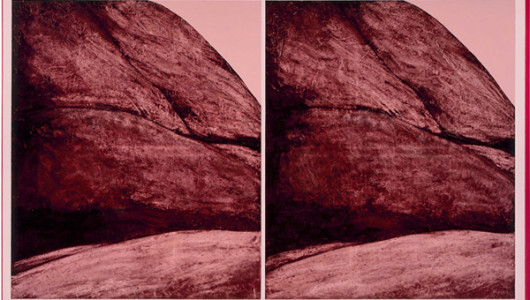
Llyn Foulkes
Good art explains nothing. There is no message. Not ever. When teachers make students explain The Tempest, for example, or Moby Dick, what exactly are they asking for? Why are they asking for this? Do they not know what it is really about? See, when schools demand such explanations, it is a way of hiding the secret meaning. I remember seeing a UK production of The Tempest, on TV, when I was around nine. Eight or nine. My father had these occasional bouts of forcing culture on me. It was a good thing, really. I remember my experience of the play. I remember not being sure they were speaking English. But I was rivited, and deeply moved, and deeply disturbed. Godzilla did not interest me, but Caliban did.
The work of Llyn Foulkes is another example of instant conviction. What I feel today is that various ideas about artworks are really like mini assassins, terms like Innovative, or Original, are ways to help the viewer or audience not see or hear. Sometimes the work announces itself as novel or original, but most often the work these days (in theatre, certainly) is sentimental and melodramatic. It is laden with message and theme. Critics will reward this, grants will be given, teaching jobs will follow.
Work like Foulks, say, or Louise Nevelson below here, seem to open and make the viewer vulnerable. Why? What do I mean by that? If in a society so permeated by authority, in which our Oedipul drama is now subcontracted, more and more, to simulacra fathers, where the Master Agency, as Lacan puts it, is mediated by an increased and open surveillance, by random but intentional displays of militarism and punishment, the sense of our psychic foundations grows murkier.
When I see Nevelson’s work in person, I often feel as if the power of her work is almost too much. Sometimes one cannot get one’s breath looking at Nevelson. Describe to me how that works? I cannot. This is why so much of the left remains as lost as Trotsky was about art’s contribution to the revolution. The radical voice is not the voice of a pamphleteer.
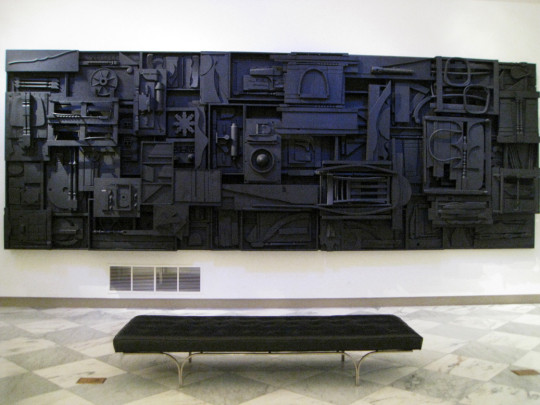
Louise Nevelson, at The Smithsonian
To return to the idea of finding a vocabulary for discrimination. I used the Tony Smith piece not because I am wildly in love with Smith. I could have used David Smith, or Robert Smithson, or twenty other sculpters. I think the greatest piece of public art, or memorial public art, a distinction actually, is the Viet Nam Memorial, by Maya Lin. In fact, it might be the only piece of memorial art I can think of that has any value. That escapes kitsch.
In the early 1600s, Bernini created a number of extraordinary work, including the Fontana del Tritone. Executed in travertine, the fountain remains authoritative even today, surrounded by traffic snarls, exhaust and high rise office buildings. But in the age of mechanical reproduction, in an age of photoshop and digital image, one wonders if the fountain were placed outside Disneyland, would it seem just another sort of cheesy plaster adornment? There are real questions about mimesis, and the collective dimension of cultural readings.
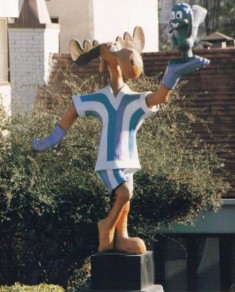
Rocky and Bullwinkle, Sunset Strip
Today, among the more influential, and probably significant artists working is James Turrell. Raised a Quaker, Turrell remains one of the few non ironic artists of any prominance. There is something, again, in Turrell that defies snark. Even the general public seems able to acede to the authority of his sincerity. Back in 1950s, Marion Milner, a psychoanalyst, wrote a book titled The Role of Illusion in Symbol Formation. She discusses her analysis of an eleven year old boy, who suffering traumatic effects from the bombing of London during the war, would create elaborate candle light rituals that included the sacrifice of toy soldiers. Milner’s point, and one Margaret Iverson makes as well, is that art and ritual and ceremony connect directly to the, at least temporary, loss of self. Or perhaps more specifically, a suspension of ego. What the point is, really, is that ritual space allows us to experience objects, and narrative, in ways not so clearly connected to pleasure or amusement. We are not being entertained. The almost tyranical ascension of the idea of “entertainment”, of fun, has always been driven by the forces of commercial gain, and commercial gain coincides with social domination. Everything in the end is about control.
Artworks that force an experience of disunity, confront daily alienation. They combat it in some way. On a simple level, it may seem hard to look at the Tony Smith, or at James Turrell, and think of disunity. But this was the real point of abstraction and then minimalism; to counter the idea of composition. In narrative, however, things work differently. Text is language, and the relationship everyone has with language is highly complex. The connection however is with the creation of a space, an unconscious realm made available, in which our own history, a history of primoridal trauma, interacts with the forces of material history bearing down on a specific place and time. History is always present. In Kitsch, in fantasy, in sci fi, history is replaced with the false promise of the wish.

Interior, Roden Crater, James Turrell
The appropriation of all material, the colonial project of domination and the extracting of value is at work as much in culture as it is in foreign policy.
Any discussion of art is compromised today by the relentless assault of mass media, the repetitive shocks of wholesale industrial level violence. The opening episode of Homeland‘s third season just aired. It may as well have been written by the Pentagon (and probably partly was). Terrorists are killed, in places such as Gaza City and Venezuela (you know, places where evil lurks). Nobody cares about trial, about proof, or much of anything outside the promotion of violence as a tonic for the soul. There are personal dramas about dignity, about conscience, but in the end, the bi-polar case officer of the CIA (the ever self parodying Claire Danes) is punished for having “irresponsible” sex, drinking, and not taking her zombie meds. The story of targeted extra legal assassination is barely thought upon. All redemption is keyed to killing, after all. The world of bath tub aesthetics is wed to the manifest sadism of popular culture. A recent study (actually several studies) link violent video games to a desensitizing in children. The problem, of course, with such studies is that they seem to ignore that almost all media encourages aggression. Identification with aggression is the hallmark of societal storytelling today. Extreme cruelty is normalized. In such a context, all discussions of aesthetics seem stopped before they begin. Again, the impaired ability to process complex narrative suggests that this increased marketing of infantile images, toys, gadgets, movies, and story is all about regression.
Children have fun. Kids have parties, and play games and make a lot of noise. The rise of the childish can be seen in daily dialogues. What exactly does “party” mean when an adult uses the word. ‘Hey, lets party’. Of course part of this is just avoidance of facing the reality of debauchery. But it’s also more, it is what children do. Girls just want to have fun. Enjoyment. Amusement. Anything but seriousness. Why so serious? The only time one is granted permission to be serious is when bathos and sentimentality are prescribed as the expected response to patriotic sacrifice or the death of white people. Never forget. Cliche, and sentimentality. Now, the loss of self is dangerous, and while the cultural apparatus is erasing memory, it must put something in its place. Identification. What one sees now is the identification with victim-hood. In a sense this is the next step up from the allure of Astrology columns. I am …..fill in the blank. I am an adult child of alcoholics. I am recovering addict. I am something. I have been diagnosed and labeled, often I am the doctor on-call for myself. Suddenly illness or handicaps of some sort can be seen as lifestyle choices. I am an Aspergers sufferer. As if this is an Identity. It is self branding. And it trivializes real suffering. The genuine schizophrenic needs therapy. The autistic needs therapy. Needs treatment. And indeed many people do suffer. The entire society probably suffers a degree of dissassociation. The petit bourgeois are most certainly, clinically, narcississtic. However, the crimes of state, the absurd level of violence by police directed at black teenagers, or the absurd mind numbing numbers of people lost in the American gulag, or the sheer societal cruelty of further cuts to the safety net. Cutting food stamps, mandatory drug tests, and restrictions on voting rights. The list is endless. Or the deaths caused by U.S. foreign policy, which barely registers on the radar of lifestyle victims. How can anyone complain about hurt feelings for christ sake, in a global catastrophe zone?
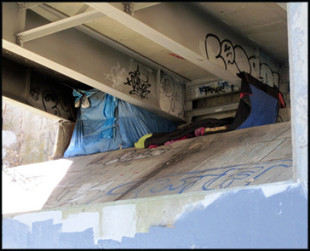
Pussy Riot !! Such bravery. Such courage. The deformed and malnourished in places such as Iraq and Afghanistan, or Haiti or Somalia, Detroit or the mining regions of West Virginia and Silesia, are only part of a backdrop of selective and mediated compassion. It is theatre, and it is bad theatre. The Spectacle demands the constant repetition of all things trivial.
So, a grammar to sustain dialogue about the art of Tony Smith or James Turrell is going to feel ever more impossible to find and develop. The films of Bresson, or Pasolini, the poetry of Celan or Lorca or Vallejo. The novels of Melville and Flannery O’Connor. A novel such as Wise Blood now stands starkly as an almost Job like narrative puzzle, an oracular meditation on authority, violence, desire and self loathing. All subjects too seriousness for a world trained to see The Avengers as 92% thumbs up, click like, and can’t wait to see it. Biggest grossing film of the year.

There are of course many ways to approach that shamanistic dream that dreams. Lacan mentions dompte regard, the tamed gaze. This is that quality of submission artworks can elicit. In Hinduism, to be within sight of the Holy man grants one Darshan, and even it is to glimpse the image of the Holy, and have the image gaze back. The audience or viewer lays down that gaze of conquest, lays down the eye of the appraiser. In the studio film of today, or the network show, there is a shiny surface of simulacra. It is labeled as documentary. And this is the central problem. Shiny objects are fine, except when they are tools of domination, of mass hypnotic states. Homeland is not a duplication of how the CIA works. It does not depict the workings of congressional hearings. It is closer to how a studio is run, and how agents work. But it is not even that. It is nothing. It is a fantastical universe of ‘play’. The eye views it with consumption in mind. The eye of the hungry man or woman, the eye of those about to buy something. Today, all there is to look at are various codes, signifiers, and simulacra..second generation dupes. A photograph of a painting, or a sculpture, retains something of (what Barthes calls) the ‘that-has-been’ quality, something of the aura of reality. Today, there are increasing numbers of works that are second generation dupes of dupes. There are shiny surfaces that grant the viewer the place and time to submit. And there are those in the service of creating further state controlled dreams. The personalized lifestyle eye, finding identification with one’s own brand. Adult survivor of an alcoholic, with restless leg syndrome, and male pattern baldness, and I am a sex addict, too, and I identify with that new Steve McQueen film, with Michael Fassbender’s character. I take possession of that commodity. I enroll in the fan club. I have now added to my brand.
There are points of reference for beauty. Vermeer is beautiful. Mozart is beautiful. There is an axiomatic belief that Titian is beautiful. Well, sort of. Classical works grow in the popular mind according to how easy it is to graph their “beauty” factor. The virus of adjectives enters play here. A film is ‘important’. A painting is ‘important’. Etc. Importance means social themes that are already agreed upon. In the abstract. Anti war films we all agree are important. But these same subjects embrace U.S. intervention by the military, they support law and order, etc. Vermeer is beautiful, but not so important. In film, beauty doesnt much matter. The audience has no idea what film is beautiful and what film is not. They do know what is ‘important’.
“Part of the source for the proliferation of trite tropes, cliches, and persistent styles lies paradoxically in inadequate or non-existent early art education and art historical instruction that is often summary, even cursory. Certainly the concepts behind the appearance of styles are not taught sufficiently if at all. Also, students do not get to see enough real artwork…”
Mira Schor
In theatre I think the education is even worse. I know two full time professors teaching theatre, that I think are good. I know a part time adjunct who I think is good. The rest are crap. The rest have no clue, no knowledge, nothing to pass on to their students but reductive aesthetic platitudes. The Institution is not there to create artists, but it should at least create an audience, an informed sophisticated audience.
But this is largely the college educated bourgeoisie. And this is largely a pointless aside, frankly. For the great tidal swell of ignorance has swept away culture from the American roadmap. Which returns this post to what really I was trying to find a way to ask. What does a society ask of its culture? What does this society ask of it.
This society asks nothing. It asks that culture fall under the aegis of Homeland Security and leisure time recreation. At work, culture is just ‘see something, say something’. At home, its Monday Night Football, or Sex and the City. And right outside are police cruisers and armored vehicles, and lots of cameras. The system is now on life support. The system is being fed by tube. And probably we are all ingesting cesium-137 and Strontium 90, and a few heavy metals, enough that at some point the grapefruit size tumors likely to grow in children over the next decade is all inevitable.
Culture cannot come out of institutional settings now. It cannot link itself to motives of profit. It must also (and this is as close to a manifesto as I’m going to get right now) release itself from the cultic notion of authorship. If it remains at all, it must be part of an instructional project of shared awareness.

Fontana del Tritone, Bernini

This is a great post. At the risk of unbecoming flattery, I felt the same way when I first saw Close: finally, someone is taking things seriously. As a small aside, since you mentioned Titian, it’s interesting to compare his Pieta — his last painting, when he was ostensibly painting for himself — with his earlier and more famous sexy-beautiful works.
Excellent, no–a superb commentary… I became aware of you, and this essay on genuine art, just today, from my recently-discovered friend, Hiroyuki Hamada, with whom I have been sharing many discussions and commentaries on Facebook, over the past 2 months or so. These have been political and geopolitical questions, among which the Syria and Iran questions have predominated, and only tangentially about the arts. I have only seen one photograph of his sculpture, a not terribly good photograph of one piece in a new show, now, in the Long Island area, perhaps in E. Hampton.
In my comment just above, just below my name, the date is given as October 3, 2013, at 1:36 am. This should read October 2, 2013 at 1:36 am, since it is still October 2nd right now…. at 6:42pm, Pacific Standard Time. For some reason it is off by one day.
John, interesting blog – my first visit! One question: I am wondering what you mean by ‘sentimental kitsch’ and if you think kitsch can ever be a good thing?
Isn’t it hypocritical to call for the elimination of the authorship of art as a concept when your website is mostly you selling yourself as an artist?